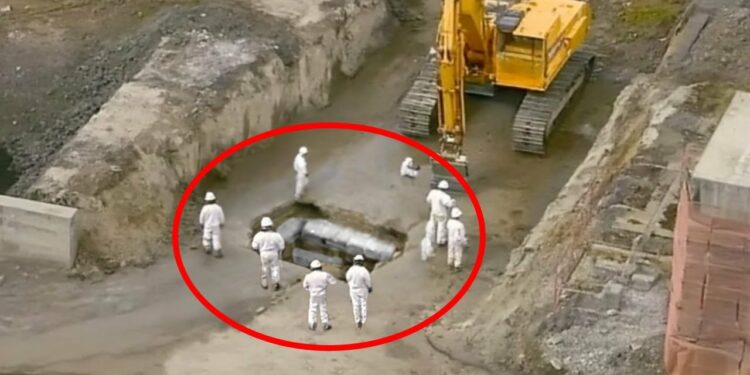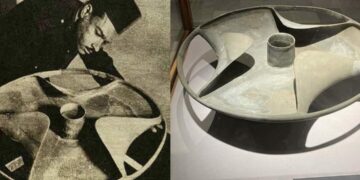Archaeologists in Egypt have unsealed a massive black sarcophagus discovered at a construction site in Alexandria. While excavations often uncover mundane items like pipes or stones, some reveal extraordinary surprises. From a nodosaur fossil to million-year-old relics, the Earth holds secrets waiting to be uncovered. Here are the top 17 shocking discoveries unearthed during digs.
Number 17: The Nodosaur
On March 21, 2011, at the Millennium Mine in Alberta, Canada, heavy equipment operator Shawn Funk uncovered a 110-million-year-old nodosaur fossil, described as the best-preserved dinosaur ever found. His excavator struck something harder than usual rock, revealing a plant-eating Cretaceous dinosaur, approximately 18 feet long and 3,000 pounds, with armored skin, spikes, and traces of its last meal intact. The fossil’s walnut-brown stones and distinctive disc pattern showcased its tough, rhinoceros-like structure, with two 20-inch shoulder spikes for defense. This breathtaking find offered unparalleled insight into the creature’s appearance and lifestyle.
Number 16: An Ancient City
In 1748, explorers digging in Italy’s Campania region rediscovered Pompeii, a Roman city buried by Mount Vesuvius’ eruption in 79 AD. Preserved under volcanic ash for nearly 2,000 years, the site revealed intact frescoes, jars of fruit, loaves of bread, and skeletal remains of inhabitants frozen in their final moments. Identified as Pompeii in 1763, the city’s houses, baths, shops, and amphitheaters provided a vivid window into Roman life, inspiring the neoclassical movement and captivating Enlightenment scholars.
Number 15: Noah’s Ark
In November 2023, archaeologists studying a geological formation in Turkey’s Doğubeyazıt district near Mount Ararat reported possible evidence of Noah’s Ark. Rock and soil samples containing clay, marine materials, and seafood traces suggest human activity from 5,500–3,000 BC, aligning with the biblical flood timeline. The 16,500-foot boat-shaped formation matches the Ark’s described dimensions. While some researchers are optimistic, skeptics argue it may be a natural rock formation, fueling ongoing debate.
Number 14: The Lost Golden City of Luxor
In 2020, archaeologists uncovered a 3,000-year-old city near Luxor, Egypt, dubbed Aten, dating to Pharaoh Amenhotep III’s reign. Led by Zahi Hawass, the excavation revealed well-preserved structures, tools, jewelry, pottery, and amulets, offering a glimpse into Egypt’s wealthiest era. The city, active during Amenhotep III, Akhenaten, Tutankhamun, and Ay’s reigns, included a bakery, administrative areas, and mud bricks stamped with Amenhotep III’s seal, hailed as one of the most significant finds since Tutankhamun’s tomb.
Number 13: Crocodile Heads
At the North Asasif necropolis near Hatshepsut’s temple, archaeologists found nine crocodile heads in elite tombs from over 4,000 years ago, belonging to high-ranking official Cheti and a vizier. Led by Dr. Patryk Chudzik, the discovery challenged known Egyptian burial practices, as crocodile remains were previously found only in temples. Wrapped in fabric, the heads were likely funerary equipment to protect the deceased in the afterlife, linked to Sobek, the crocodile deity symbolizing strength and protection.
Number 12: A Ferrari
In February 1978, two boys in Los Angeles discovered a buried 1974 Ferrari Dino 246 GTS, stolen in 1974 from Rosendo Cruz after his anniversary dinner. Preserved with tarps and carpets, the car was intact despite open windows. Investigations revealed Cruz had conspired with thieves in an insurance fraud scheme, intending to dismantle the car for parts. Instead, it was buried and forgotten. Sold at auction by Farmers Insurance, it was restored by businessman Brad Howard, who still drives it.
Number 11: Machimosaurus Rex
Paleontologists uncovered Machimosaurus Rex, a 30-foot, 3-ton sea-dwelling crocodile from the Cretaceous Period, near Casablanca, Morocco. Led by Federico Fanti, the find revealed a versatile hunter with stocky teeth and a powerful skull, likely ambushing marine turtles and fish. Its existence challenges assumptions about mass extinctions, suggesting marine reptiles thrived despite environmental upheaval, reshaping our understanding of prehistoric ecosystems.
Number 10: World’s Oldest Runestone
In 2021, archaeologists in Norway found the world’s oldest datable runestone near Tyrifjord, west of Oslo. The Svinger Stone, a 31×32 cm sandstone block from AD 1–250, features runic inscriptions, including “idug,” possibly a name. Discovered by Kristel Zilmer, it offers new insights into early Scandinavian runic writing and is displayed at Oslo’s Museum of Cultural History.
Number 9: Bronze Statues
In Tuscany’s San Casciano dei Bagni, archaeologists unearthed 24 bronze statues over 2,300 years old, preserved in mineral-rich mud. Created by Etruscans and later Romans, the statues include a sleeping ephebe, Hygeia with a serpent, and figures of emperors and children. Hailed as a rare find, the collection, along with coins and inscriptions, highlights the therapeutic baths’ cultural significance from the 3rd century BC.
Number 8: 66-Million-Year-Old Fossil
Near Casablanca, Morocco, paleontologists discovered Thalassotitan atrox, a 30-foot marine reptile from just before the dinosaur-extincting asteroid impact. With massive jaws and worn teeth, it preyed on plesiosaurs, indicating mosasaurs were thriving, not declining, before the mass extinction. Dr. Nick Longrich described it as a nightmarish blend of a Komodo dragon, great white shark, T-Rex, and killer whale.
Number 7: Dinosaur Tracks
In 2022, a drought in Central Texas revealed 113-million-year-old dinosaur tracks at Dinosaur Valley State Park. The Lone Ranger Trackway, made by an Acrocanthosaurus, a 15-foot, 7-ton predator, includes about 140 tracks, with 60 visible. Preying on sauropods like Paluxysaurus, these well-preserved tracks highlight how extreme weather can uncover ancient history.
Number 6: Medieval Water Tunnel
In Winchester, Hampshire, the Hyde 900 charity uncovered a medieval water tunnel near Hyde Abbey, once home to King Alfred the Great. The vaulted channel supplied water to the abbey’s cloisters, kitchens, and latrines. Led by David Spurling, the dig also found medieval tiles, Roman pottery, bones, and oyster shells, revealing the abbey’s sophisticated engineering and community life.
Number 5: Oldest Human Footprints
At White Sands National Park, New Mexico, fossilized footprints dated 21,000–23,000 years old were found, potentially the oldest evidence of human presence in the Americas. Confirmed by pollen and quartz grain dating, the 2021 discovery, studied by Thomas Urban and Kathleen Springer, challenges migration timelines, suggesting humans arrived earlier than previously thought.
Number 4: Ukrainian Stonehenge
Near Novo Alexandria, Ukraine, archaeologists uncovered a 5,300–5,500-year-old burial mound, dubbed Ukrainian Stonehenge. The 7.5m-high, 50m-wide kurgan contained 64 stone boulders in a circular formation, skeletons in 11 alcoves, and traces of mummification with red ochre. Led by Dmytro Teslenko, the find reflects Indo-European burial traditions, with plans for an open-air museum.
Number 3: Golden-Tongued Mummy
In 2021, at Taposiris Magna, Egypt, archaeologists found a 2,000-year-old mummy with a golden tongue, likely to aid communication with Osiris in the afterlife. Led by Kathleen Martinez, the dig uncovered 16 burials, coins with Cleopatra VII’s likeness, and mummies with scrolls and death masks, highlighting ancient Egyptian spiritual practices.
Number 2: Jerubbaal Inscription
In July 2021, a 3,100-year-old pottery fragment inscribed with “Jerubbaal,” linked to the biblical judge Gideon, was found at Khirbet el-Rai, Israel. Dating to 1100 BC, the jug fragment suggests alphabetic script continuity after the fall of Tel Lachish, offering insights into ancient Israel’s literacy and biblical history.
Number 1: Pharaoh’s Tomb
At Saqqara, Egypt, a 4,400-year-old tomb of high priest Wahati, from the Fifth Dynasty under King Neferirkare Kakai, was uncovered in 2018. Described by Mostafa Waziri as one-of-a-kind, the well-preserved tomb features vibrant hieroglyphs, statues, and carvings of Wahati with his family, offering a rare glimpse into ancient Egyptian burial practices and priestly roles.























